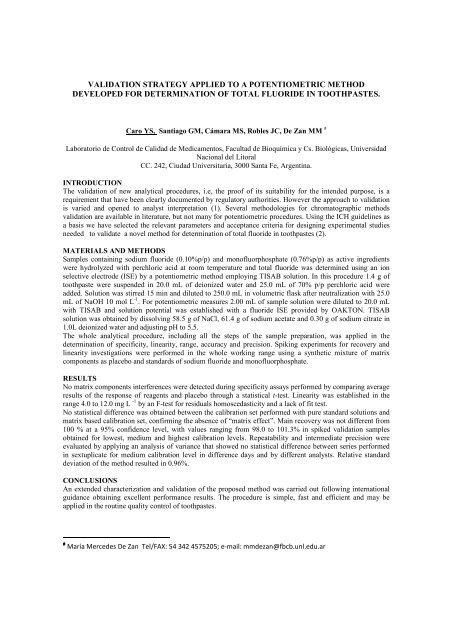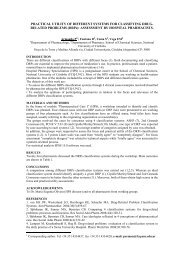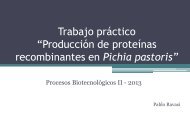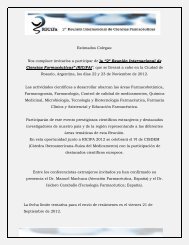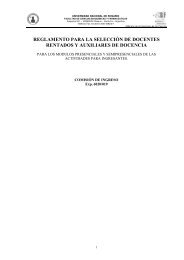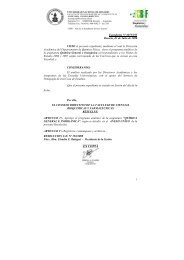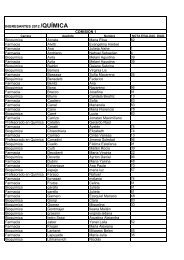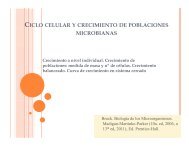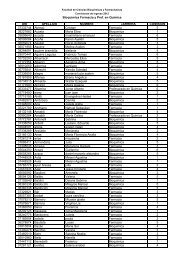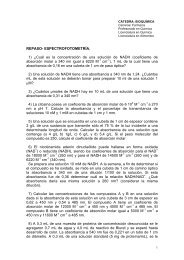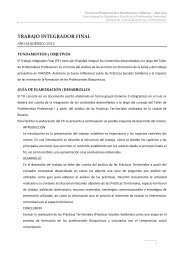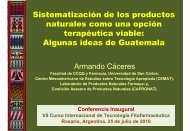validation strategy applied to a potentiometric method developed for ...
validation strategy applied to a potentiometric method developed for ...
validation strategy applied to a potentiometric method developed for ...
You also want an ePaper? Increase the reach of your titles
YUMPU automatically turns print PDFs into web optimized ePapers that Google loves.
VALIDATION STRATEGY APPLIED TO A POTENTIOMETRIC METHODDEVELOPED FOR DETERMINATION OF TOTAL FLUORIDE IN TOOTHPASTES.Caro YS, Santiago GM, Cámara MS, Robles JC, De Zan MM #Labora<strong>to</strong>rio de Control de Calidad de Medicamen<strong>to</strong>s, Facultad de Bioquímica y Cs. Biológicas, UniversidadNacional del Li<strong>to</strong>ralCC. 242, Ciudad Universitaria, 3000 Santa Fe, Argentina.INTRODUCTIONThe <strong>validation</strong> of new analytical procedures, i.e, the proof of its suitability <strong>for</strong> the intended purpose, is arequirement that have been clearly documented by regula<strong>to</strong>ry authorities. However the approach <strong>to</strong> <strong>validation</strong>is varied and opened <strong>to</strong> analyst interpretation (1). Several <strong>method</strong>ologies <strong>for</strong> chroma<strong>to</strong>graphic <strong>method</strong>s<strong>validation</strong> are available in literature, but not many <strong>for</strong> <strong>potentiometric</strong> procedures. Using the ICH guidelines asa basis we have selected the relevant parameters and acceptance criteria <strong>for</strong> designing experimental studiesneeded <strong>to</strong> validate a novel <strong>method</strong> <strong>for</strong> determination of <strong>to</strong>tal fluoride in <strong>to</strong>othpastes (2).MATERIALS AND METHODSSamples containing sodium fluoride (0.10%p/p) and monofluorphosphate (0.76%p/p) as active ingredientswere hydrolyzed with perchloric acid at room temperature and <strong>to</strong>tal fluoride was determined using an ionselective electrode (ISE) by a <strong>potentiometric</strong> <strong>method</strong> employing TISAB solution. In this procedure 1.4 g of<strong>to</strong>othpaste were suspended in 20.0 mL of deionized water and 25.0 mL of 70% p/p perchloric acid wereadded. Solution was stirred 15 min and diluted <strong>to</strong> 250.0 mL in volumetric flask after neutralization with 25.0mL of NaOH 10 mol L -1 . For <strong>potentiometric</strong> measures 2.00 mL of sample solution were diluted <strong>to</strong> 20.0 mLwith TISAB and solution potential was established with a fluoride ISE provided by OAKTON. TISABsolution was obtained by dissolving 58.5 g of NaCl, 61.4 g of sodium acetate and 0.30 g of sodium citrate in1.0L deionized water and adjusting pH <strong>to</strong> 5.5.The whole analytical procedure, including all the steps of the sample preparation, was <strong>applied</strong> in thedetermination of specificity, linearity, range, accuracy and precision. Spiking experiments <strong>for</strong> recovery andlinearity investigations were per<strong>for</strong>med in the whole working range using a synthetic mixture of matrixcomponents as placebo and standards of sodium fluoride and monofluorphosphate.RESULTSNo matrix components interferences were detected during specificity assays per<strong>for</strong>med by comparing averageresults of the response of reagents and placebo through a statistical t-test. Linearity was established in therange 4.0 <strong>to</strong> 12.0 mg L -1 by an F-test <strong>for</strong> residuals homoscedasticity and a lack of fit test.No statistical difference was obtained between the calibration set per<strong>for</strong>med with pure standard solutions andmatrix based calibration set, confirming the absence of “matrix effect”. Main recovery was not different from100 % at a 95% confidence level, with values ranging from 98.0 <strong>to</strong> 101.3% in spiked <strong>validation</strong> samplesobtained <strong>for</strong> lowest, medium and highest calibration levels. Repeatability and intermediate precision wereevaluated by applying an analysis of variance that showed no statistical difference between series per<strong>for</strong>medin sextuplicate <strong>for</strong> medium calibration level in difference days and by different analysts. Relative standarddeviation of the <strong>method</strong> resulted in 0.96%.CONCLUSIONSAn extended characterization and <strong>validation</strong> of the proposed <strong>method</strong> was carried out following internationalguidance obtaining excellent per<strong>for</strong>mance results. The procedure is simple, fast and efficient and may be<strong>applied</strong> in the routine quality control of <strong>to</strong>othpastes.# María Mercedes De Zan Tel/FAX: 54 342 4575205; e-mail: mmdezan@fbcb.unl.edu.ar
ACKNOWLEDGMENTSThe authors thank UNL <strong>for</strong> financial support from “Proyec<strong>to</strong> CAI+D 2009 Tipo II PI-12-62and Labora<strong>to</strong>rio LAFORMED S.A. <strong>for</strong> providing drugs and pharmaceuticalsREFERENCES(1) Ermer J.Validation in pharmaceutical analysis. PartI: An integrated approach.J Pharm Biomed Anal.2001;24:755-767(2) Norma Oficial Mexicana PROY-NOM-219-SSA1.2002.


